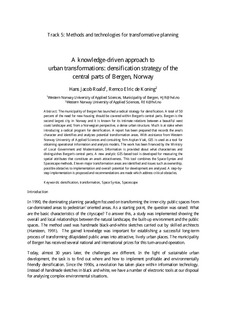A knowledge driven approach to urban transformation: Densification strategy of Bergen, Norway
Lecture
Submitted version

Åpne
Permanent lenke
http://hdl.handle.net/11250/2620269Utgivelsesdato
2019Metadata
Vis full innførselSamlinger
- Import fra CRIStin [3621]
- Institutt for byggfag [293]
Originalversjon
Roald, H. J., & de Koning, R. E. (2019). A knowledge driven approach to urban transformation: Densification strategy of Bergen, Norway. AESOP annual congress 2019.Sammendrag
The municipality of Bergen has launched a radical strategy for densification. A total of 50 percent of the need for new housing should be covered within Bergen's central parts. Bergen is the second largest city in Norway and it is known for its intimate relations between a beautiful west coast landscape and, from a Norwegian perspective, a dense urban structure. Much is at stake when introducing a radical program for densification. A report has been prepared that records the area's character and identifies and analyses potential transformation areas. With assistance from Western Norway University of Applied Sciences and consulting firm Asplan Viak, GIS is used as a tool for obtaining operational information and analysis models. The work has been financed by the Ministry of Local Government and Modernisation. Information is provided about what characterises and distinguishes Bergen's central parts. A new analytic GIS-based tool is developed for measuring the spatial attributes that constitute an area's attractiveness. This tool combines the Space-Syntax and Spacescape methods. Eleven major transformation areas are identified and issues such as ownership, possible obstacles to implementation and overall potential for development are analysed. A step-bystep implementation is proposed and recommendations are made which address critical obstacles.